Minerals and rocks are the essential building blocks of the geosphere. Although there are over 3,000 species of minerals, only a few of them, such as quartz, feldspar, mica, amphibole, pyroxene, olivine and calcite, occur commonly as rock-forming minerals. Rocks are classified into three main types, igneous, sedimentary, and metamorphic, depending upon their mode of formation. Over geological time, rocks gradually are transformed from one type to another in what is termed the Rock Cycle. The origin of any particular rock can be determined by careful examination of its texture, composition, and internal structure, features that form the basis of rock identification and classification.
What are Minerals?
Minerals are the fundamental components of rocks. They are naturally occurring inorganic substances with a specific chemical composition and an orderly repeating atomic structure that defines a crystal structure.
Silicate minerals are the most abundant components of rocks on the Earth's surface, making up over 90% by mass of the Earth's crust. The fundamental chemical building block of silicate minerals is the chemical compound silicon tetroxide, SiO4 (Figure 1).
The common non-silicate minerals, which constitute less than 10% of the Earth's crust, include carbonates, oxides, sulphides, phosphates and salts. A few elements may occur in pure form. These include gold, silver, copper, bismuth, arsenic, lead, tellurium and carbon.
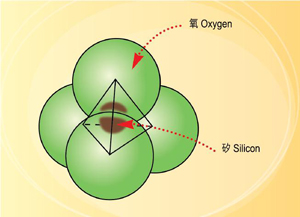
Figure 1. Silicon tetroxide, SiO4.
Although 92 naturally occurring elements exist in nature, only eight of these are common in the rocks of the Earth's crust. Together, these eight elements make up more than 98% of the crust (Table 1).
| Table 1. The eight most common elements in the Earth's crust (by mass). | |
|---|---|
| Oxygen (O) | 46.6% |
| Silicon (Si) | 27.7% |
| Aluminium (Al) | 8.1% |
| Iron (Fe) | 5.0% |
| Calcium (Ca) | 3.6% |
| Sodium (Na) | 2.8% |
| Potassium (K) | 2.6% |
| Magnesium (Mg) | 2.1% |
Classification and Identification
Minerals are classified according to their chemical composition.
The physical properties of minerals, such as their hardness, lustre, colour, cleavage, fracture and relative density, can be used to identify minerals. These general characteristics are controlled mainly by their atomic structure (crystal structure).
Common Rock-forming Minerals
Quartz
- Quartz (Figure 2), which is usually called silica, is one of the most common minerals in the Earth's crust.
- Quartz is made up of silicon dioxide (SiO2).
- Quartz crystals are usually hexagonal and prismatic in shape.
- Pure quartz is colourless, although the presence of impurities may give a range of colours, such as violet, pink and orange.
- Quartz is the raw material for making glass.
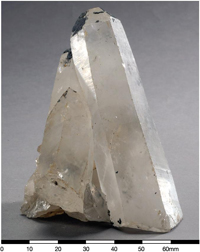
Figure 2: Quartz.
Plagioclase feldspar
- Plagioclase feldspar (Figure 3) is a sodium- or calcium-rich feldspar. The chemical composition ranges from sodium aluminium silicate, NaAlSi3O8 to calcium aluminium silicate, CaAl2Si2O8.
- Plagioclase feldspar crystals usually occur as stubby prisms.
- Plagioclase feldspar is generally white to grey and has a vitreous lustre.
- Plagioclase feldspar is an important industrial mineral used in ceramics.
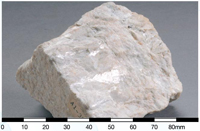
Figure 3: Plagioclase feldspar.
Alkali Feldspar
- Alkali feldspar (Figure 4) is another member of the family of feldspar minerals.
- Alkali feldspar (Potassium aluminium silicate (K,Na)AlSi3O8) are rich in alkali metal ions.
- Alkali feldspar crystals usually occur as stubby prisms.
- Alkali feldspar is commonly pink to white.
- Alkali feldspar is used as raw material to make porcelain.
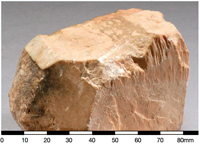
Figure 4: Alkali feldspar.
Micas
- Micas are a family of silicate minerals.
- Micas are made up of varying amounts of potassium, magnesium, iron, as well as aluminium, silicon and water.
- Micas form flat, book-like crystals that split into individual sheets, separating into smooth flakes along the cleavage planes.
- They are common minerals in intrusive igneous rocks, and can also be found in sedimentary and metamorphic rocks.
- Biotite (Figure 5) is a dark, black or brown mica; muscovite (Figure 6) is a light-coloured or clear mica.
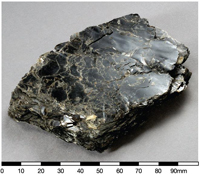
Figure 5: Biotite.
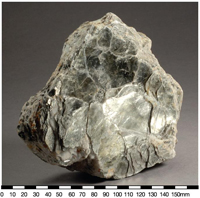
Figure 6: Muscovite.
Amphiboles
- Amphiboles are a family of silicate minerals.
- Amphibole minerals generally contain iron, magnesium, calcium and aluminium as well as silicon, oxygen, and water.
- Amphiboles form prismatic or needle-like crystals.
- Amphibole is a component of many igneous and metamorphic rocks.
- Hornblende (Figure 7) is a common member of the amphibole group of rock-forming minerals.
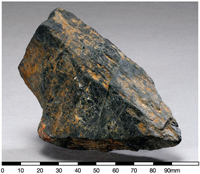
Figure 7: Hornblende.
Pyroxene
- Pyroxenes (Figure 8) are a family of silicate minerals.
- Pyroxene minerals generally contain magnesium, iron, calcium and aluminium as well as silicon and oxygen.
- Pyroxenes form short or columnar prismatic crystals.
- Pyroxene is a component in many igneous and metamorphic rocks.
- Pyroxene crystals are commonly faceted as gemstones. For instance, precious jade (jadeite) is a pyroxene.
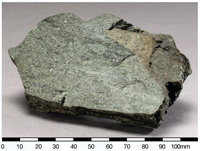
Figure 8: Pyroxene.
Olivine
- Olivine (Figure 9) is a silicate mineral.
- Olivine ((Mg,Fe)2SiO4) contains iron and magnesium.
- Olivine is a green, glassy mineral.
- Olivine is common in mafic and ultramafic rocks, but has not been found in Hong Kong.
- Clear and transparent olivine crystals are commonly faceted as gemstones.
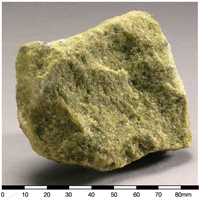
Figure 9: Olivine.
Calcite
- Calcite (Figure 10) is a carbonate mineral.
- Calcite is made up of calcium carbonate (CaCO3).
- Calcite is generally white to clear, and is easily scratched with knife.
- Calcite is a common sedimentary mineral that is the major component of calcareous sedimentary rocks such as limestone. Metamorphism of limestone produces marble.

Figure 10: Calcite.
What are Rocks?
Rocks are naturally occurring aggregates of minerals, rock fragments or organic matter. The composition of a rock, as well as the appearance, shape, and arrangement of the grains or crystals within the rock (i.e. its texture), are the characteristics that reveal its process of formation. Based on their mode of formation, rocks are classified into three main types: igneous, sedimentary and metamorphic.
Introduction to Rock Identification
In most cases, it is not possible to directly observe how rocks are formed. Therefore, it is necessary to rely on the distinctive features of a rock to infer its origin. Texture and mineral composition are two important characteristics that may help to confirm the origin of a rock.
- Texture refers to the sizes and shapes of the component minerals or grains, and to their collective arrangement in a rock.
- Composition refers to the crystals, mineral grains, fragments of other rocks, and/or fossils, that make up a rock. It also refers to the chemical constituents of a rock. The colour of a rock may also provide an important guide to its composition.
The identification and classification of rocks is a skilled task that requires a broad understanding of geology and considerable experience.
Igneous Rocks
Igneous rocks form when hot, molten rock (magma) cools and solidifies. The magma originates deep within the Earth near active plate boundaries or hot spots, then rises toward the surface. Igneous rocks are sub-divided into either intrusive or extrusive rocks, depending upon where in the Earth the magma solidifies (Figure 11).
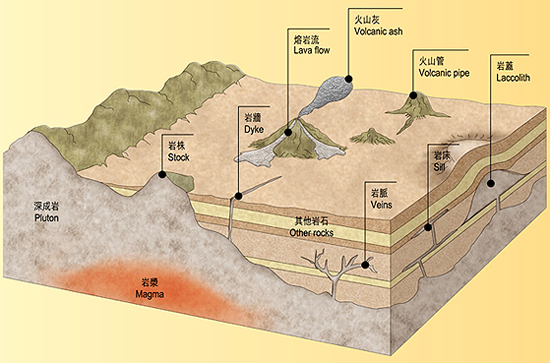
Figure 11: Various Forms of Igneous Rocks.
- Intrusive, or plutonic, igneous rocks are formed when rising magma is trapped deep within the Earth, where it cools very slowly over many thousands or millions of years until it finally solidifies. Slow cooling allows the individual mineral grains sufficient time to grow and form relatively large crystals. Intrusive rocks have a coarse-grained texture with interlocking minerals. Granite is a commonly occurring intrusive rock in Hong Kong.
- Extrusive, or volcanic, igneous rocks are produced when magma is erupted at, or very near, the Earth's surface. The erupted magma cools and solidifies relatively quickly when it is exposed to the cooler temperatures of the atmosphere. Lava and tuff are two common volcanic rocks.
Characteristics of Intrusive Igneous Rocks
Granitic Rocks
- Granitic rocks contain predominantly feldspar and quartz minerals, with subordinate amphiboles, and micas.
- Granitic rocks occur as plutons, dykes or sills (Figure 11).
- Individual minerals can generally be identified with the naked eye (Figure 12 & 13).
- Minerals are crystalline and show an interlocking texture (Fingure 12 & 13).
- Unweathered granite is commonly pinkish grey or light grey in colour.
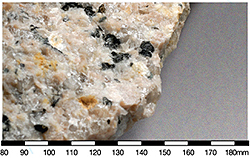
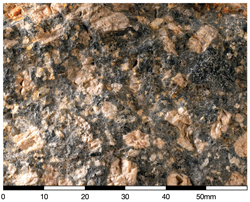
Characteristics of Extrusive Igneous Rocks
Lava
- Individual mineral grains in lava are generally too small to be identified with the naked eye.
- Lava may contain some larger crystals (phenocrysts) within the fine-grained groundmass.
- Lava may display a flow fabric.
Tuff
- Tuff (Figure 14) contains fragments of minerals, glass, pumice and/or pre-existing rocks.
- Tuff is classified on the basis of the relative components of the various fragments.
- The fragments are generally angular and broken.
- Tuff is commonly dark grey in colour when the rock is unweathered.
- The rock may show a welding structure (Figure 15).
- Some tuff is columnar-jointed.
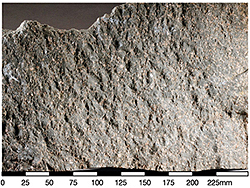
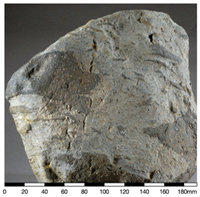
Sedimentary Rocks
Sedimentary rocks are formed from the eroded fragments of pre-existing rocks, or from the skeletal fragments of once-living plants or organisms. They accumulate in various environments on the Earth's surface. Sedimentary rocks commonly have distinctive layering or bedding. Sedimentary rocks are sub-divided into three groups, including clastic, biological and chemical.
- Clastic sedimentary rocks are made up of fragments (clasts) of pre-existing rocks. Crystals or fragments of the pre-existing rocks are loosened by weathering, and subsequently transported to a site where they are deposited. Clastic sedimentary rock is formed when the sediment is buried, then compacted and cemented.
- Biological sedimentary rocks form when large quantities of living plants or organisms die and accumulate. Their remains are broken down, compressed and cemented to form rock. Accumulations of carbon-rich plant material may form coal. Deposits composed mainly of animal shells may form limestone or chert.
- Chemical sedimentary rocks are formed by chemical precipitation from solutions. This process begins when water passes through rock dissolving some of the minerals and carrying them away from their source. Eventually the minerals are deposited, or precipitated, when the water evaporates or when the water becomes over-saturated with minerals. Rock salts are examples of chemical sedimentary rocks.
Characteristics of Sedimentary Rocks
Clastic Sedimentary Rocks (Siltstone, Sandstone and Conglomerate)
- Clastic sedimentary rocks are composed of rock and mineral grains eroded from pre-existing rocks (Figure 16).
- Individual grains are held together by a cement that is commonly composed of quartz or calcite minerals.
- Clastic sedimentary rocks may contain fossils.
- Sedimentary bedding may be present, defined by variations in the texture and composition of the constituent grains that are systematically arranged in layers.
- Colour variations reflect composition, the depositional environment of the sediments and/or the texture and weathering state.
The naming of clastic sedimentary rocks is based on grain size and shape of the clasts (Table 2). For example, siltstone (Figure 17) is an aggregate of silt-sized grains, whereas sandstone is composed of sand-sized grains.
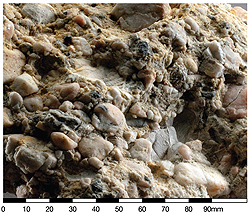
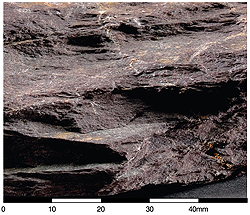
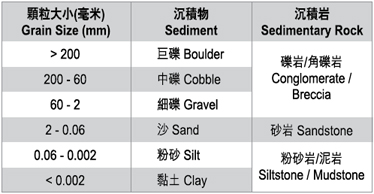
Metamorphic Rocks
Metamorphic rocks are formed when a pre-existing rock is subject to high temperature, high pressure, hot and mineral-rich fluid, or a combination of these conditions. The original rocks could be igneous, sedimentary, or earlier metamorphic rocks. In the case of metamorphic rocks, some or all of the original minerals are replaced by new minerals, and the original textures are commonly masked due to the deformation (such as shearing and folding) that may accompany metamorphism. Metamorphic rocks are generally formed deep within the Earth, or where tectonic plates meet.
- Foliated metamorphic rocks exhibit a platy or sheet-like structure. Foliation develops when platy or prismatic minerals within the rock are compressed and aligned under extreme pressure. The foliation pattern reflects the direction in which pressure was applied. Slate, schist, and gneiss are examples of foliated metamorphic rocks.
- Non-foliated metamorphic rocks display a massive structure. Non-foliated metamorphic rocks can be formed by contact metamorphism that occurs around intrusive igneous rocks. The pre-existing rocks that come into contact with the intruding igneous rocks are essentially baked by the heat. In this case, the mineral structures of the pre-existing rocks are changed without being subjected to intense pressure. Quartzite and marble are examples of non-foliated metamorphic rocks.
Characteristics of Metamorphic Rocks
Schist and Phyllite
- The minerals of the original rock may be replaced by new metamorphic minerals, such as micas (platy minerals) and amphibole (a prismatic mineral).
- The rocks show a foliation, which is defined by the alignment of platy or elongate prismatic minerals (Figure 18).
- The rocks commonly display alternating dark and light coloured bands that reflect the concentration of dark and light coloured minerals.
- The rocks generally display a silky or shiny appearance due to the presence of micas.
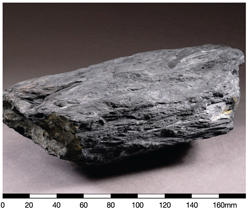
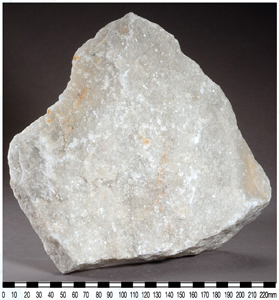
Marble
- Marble is composed of crystalline calcite minerals (Figure 19).
- Pure marble is in white or creamy colour, but impure marble may be light grey to bluish grey.
- Marble reacts with dilute hydrochloric acid to produce gas bubbles (effervescence).

- The rock is easily scratched with a knife.
- The mineral grains are interlocking
The Rock Cycle
The Rock Cycle (Figure 20) is a conceptual model that explains how geological processes acting on any one of the three main rock types - igneous, sedimentary and metamorphic - can change one rock type to another over geological time. Plate tectonics is the driving force of the Rock Cycle.
In order to understand the Rock Cycle, it is important to understand the rock-forming processes.
- Igneous rock-forming processes involve melting, cooling and crystallization.
- Sedimentary rock-forming processes involve weathering, erosion, deposition, burial and lithification.
- Metamorphic rock-forming processes involve changes to rock textures and mineral compositions under different temperature, pressure or hot fluid conditions.
The Rock Cycle can begin with any one of the three rock types. It is important to understand that a rock does not necessarily pass all the way through the Rock Cycle from igneous, to sedimentary, to metamorphic, and back to igneous rock again. For example, an igneous rock can become a metamorphic rock without reaching the Earth's surface, and without first becoming a sedimentary rock. Also, any type of rock can become a new rock of the same type.
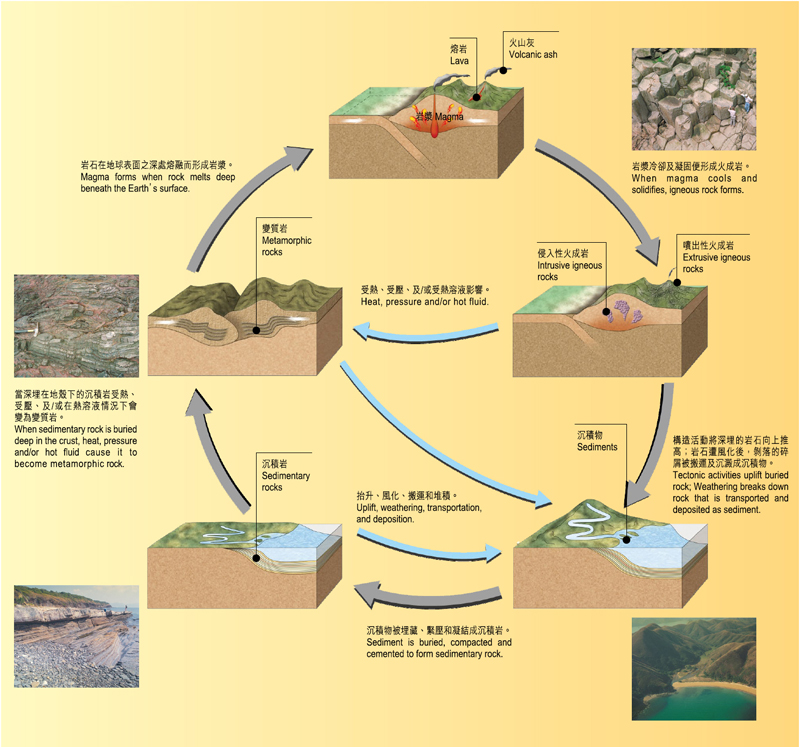
Figure 20: The Rock Cycle.